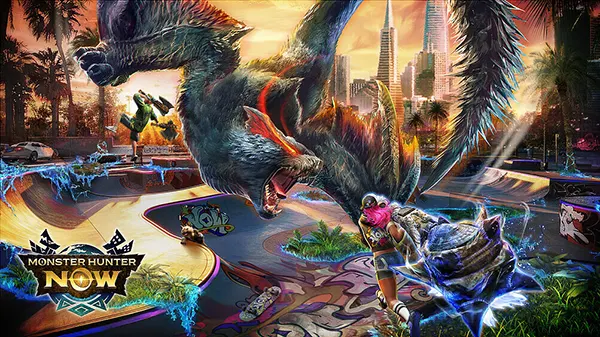Monster Hunter Now brings Capcom’s iconic monster-slaying franchise into real-world environments through augmented reality (AR). Developed in collaboration with Niantic, the creators of Pokémon GO, this mobile game lets players explore their neighbourhoods to hunt, battle and collect massive monsters. Released globally in September 2023, the game continues to receive major updates throughout 2024 and into June 2025, solidifying its place as a standout in the AR gaming landscape.
Real-World Exploration with AR Mechanics
The core gameplay of Monster Hunter Now encourages physical activity, requiring players to walk through real-world streets and parks to discover monsters. Locations vary based on biome types such as forest, desert or swamp, which rotate periodically. This dynamic environment keeps the exploration fresh and geographically diverse.
Using the mobile phone’s GPS and camera, players can encounter life-size monsters, visually superimposed on their surroundings. Engaging in combat feels immersive and satisfying, especially when larger beasts loom over landmarks or urban infrastructure. The AR functionality blends fantasy with reality in a unique and intuitive way.
The “Paintball” feature allows players to mark monsters they cannot fight immediately. These marked creatures can be fought later from home, offering a flexible gaming experience without punishing players with limited mobility or time.
Combat, Crafting, and Character Progression
Battle mechanics in Monster Hunter Now are streamlined for mobile devices, with intuitive swipe and tap controls. Despite this simplification, combat retains the core intensity and strategy of the mainline Monster Hunter series. Timed dodges, elemental weaknesses, and weapon-specific combos are all present.
Defeated monsters drop materials that can be used to craft and upgrade weapons and armour. This loop of hunting, collecting, and upgrading mirrors the familiar progression path of traditional entries in the franchise. Each weapon class, from Great Sword to Bow, offers a different playstyle and pacing.
Players can also join hunting parties to take down stronger foes. While multiplayer isn’t real-time in the same way as console titles, asynchronous cooperative gameplay through shared targets and paintballs enables community engagement and collaboration.
Latest Features and Seasonal Events (as of June 2025)
As of June 2025, Monster Hunter Now includes more than 50 large monsters, including fan favourites like Rathalos, Zinogre, and Diablos. Niantic regularly introduces seasonal events and limited-time hunts, incentivising daily play and long-term commitment.
The Spring 2025 event saw the debut of Kushala Daora in urban biomes, marking the introduction of elder dragons. These powerful monsters require coordinated efforts from multiple players and offer rare materials needed for elite gear.
New weapon types were also added in the May 2025 update, with Dual Blades becoming a favourite due to their fast-paced action. Players now have the option to personalise their gear with cosmetic skins, enhancing visual appeal while preserving balance.
Community Building and Local Collaboration
Monster Hunter Now encourages community interaction through scheduled local meetups, where players in specific regions collaborate to complete event-based objectives. These gatherings help foster teamwork and create a sense of belonging among players.
Niantic has also partnered with local businesses to create in-game zones where rare monsters appear more frequently. These sponsored zones include real-world cafes, bookstores, and recreational centres, bringing the game closer to everyday life.
Official Discord servers and in-app guilds have grown in popularity, allowing players to coordinate paintball strategies, exchange tips, and share gear builds. These digital spaces complement the physical movement of the game with deeper tactical planning.

Technical Performance and Device Compatibility
Monster Hunter Now is optimised for both Android and iOS devices, supporting phones with at least 4GB of RAM and ARCore or ARKit functionality. Regular patches ensure smooth performance, with graphical settings adaptable to lower-end models for wider accessibility.
Battery usage remains a challenge during extended play sessions, but the introduction of Power Saving Mode and optional AR toggles helps mitigate drain. The game runs steadily even in crowded cityscapes, demonstrating thoughtful engineering on the backend.
As of June 2025, the game supports over 12 languages and is available in more than 70 countries. Niantic has focused on localisation efforts to ensure region-specific gameplay and text feel natural and inclusive for all players.
Future Outlook and Long-Term Support
Niantic and Capcom have confirmed that Monster Hunter Now will receive continuous support through at least 2026. Roadmaps released in early 2025 detail upcoming content such as PvP modes, weather-based monster behaviours, and crossovers with other Capcom properties.
The game’s monetisation model, based on optional purchases for cosmetics and time-saving items, has been well-received. Players can enjoy the full game loop without spending money, ensuring fair progression across all tiers of players.
With a loyal fan base, strong update cadence, and a unique hybrid of movement-based gameplay and fantasy combat, Monster Hunter Now stands as a benchmark for future AR-based action games. Its success highlights the viability of blending physical exploration with deep, franchise-rooted mechanics.